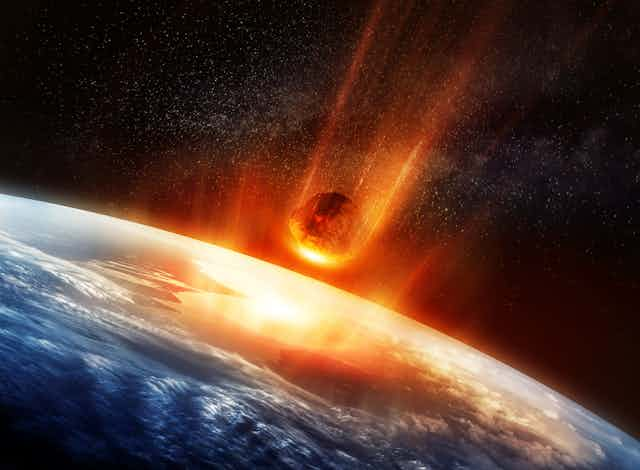The end of the Cretaceous period 66 million years ago was a rough time to be living on Earth.
Three global catastrophes occurred nearly simultaneously: The Chicxulub meteorite slammed into what is now Mexico’s Yucatan Peninsula, the massive Deccan Traps volcanic province in modern-day India erupted, and some three-quarters of Earth’s plants and animals, including all non-avian dinosaurs, went extinct. The occurrence of these three events at the same time in our planet’s history has fueled a decades-long debate about causal links. Either a large sequence of volcanic eruptions or an extraterrestrial impact could conceivably cause a mass extinction – but were they all somehow connected?
As Earth scientists, we have reason to believe that there may be another event to add to the list. Our new research, published in Science Advances, shows that the Chicxulub impact may have triggered additional volcanic activity far from the Deccan Traps – along tens of thousands of miles of undersea volcanic ridges that lie at the edges of tectonic plates. The meteorite impact caused large seismic waves that traveled around the globe and were apparently capable of flushing magma out of the mantle and into the oceanic crust. This would presumably be more bad news for the dinosaurs and other flora and fauna of the time.
Ripple effects of seismic activity
It is well known that seismic activity can trigger a variety of hydrologic phenomena, and sometimes even volcanic eruptions. In the aftermath of nearby large earthquakes, dry streams can start flowing, well levels can go up or down, and geysers sometimes erupt. Seismicity also sets off volcanic activity, but only when conditions are just right – it’s only about 0.4 percent of explosive volcanic eruptions that might be triggered by large earthquakes.
So could the massive earthquake generated when the Chicxulub meteorite crashed into Earth be related to the ongoing eruptions in the Deccan Traps? This volcanic province covered much of India with lava flows in less than a million years. A University of California, Berkeley-led team of researchers (including one of us, Leif Karlstrom) revisited the possibility of a connection between these two events.
The most recent efforts to date these eruptions have clearly shown that the Deccan Traps began spewing lava before the meteorite impact and the mass extinction occurred. But the Berkeley-led study suggested that the Chicxulub impact triggered a rapid increase in their eruption rate. If true, all three events could conceivably be connected: The impact would be followed by accelerated volcanic activity that could contribute to the mass extinction.
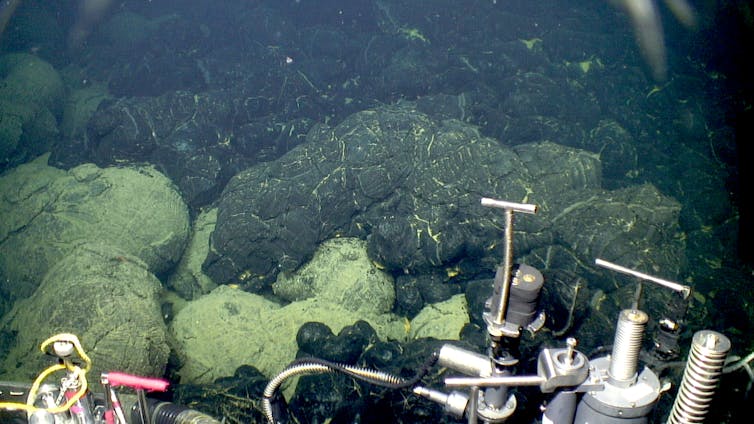
Looking to the ocean floor
If the triggering-by-impact hypothesis is right, we’d expect that other volcanic systems would have been set off as well.
At any given time, the vast majority of the volcanic activity on Earth isn’t occurring in continent-covering floods of magma or in explosions like at Mount St. Helens. It’s on the seafloor, where the tectonic plates are spreading apart. As the Earth’s crust splits, the mostly solid mantle layer rises to fill the space created. It melts as it decompresses on the way up.
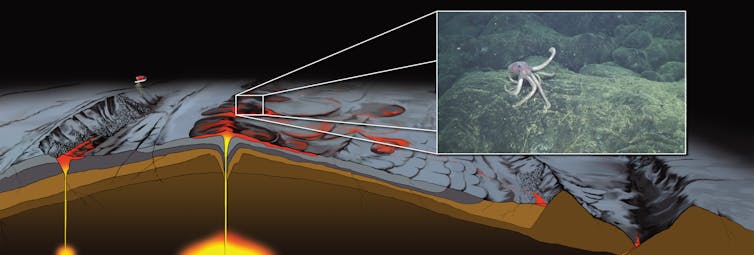
This new magma percolates its way to the surface and fuels nearly continuous volcanic activity along what are known as mid-ocean ridges. This process creates practically all of the crust on the bottom of the ocean. Since the ages of the seafloor are relatively well-known, it preserves a record of oceanic volcanic activity stretching back over 100 million years. This remarkable record of volcanic activity creates an opportunity to test the triggering hypothesis.
In our new study, we used publicly available data sets to make a record of the structure of the seafloor stretching back 100 million years. Since better topographic maps exist for Mars and Venus than do for the Earth’s seafloor on a global scale, we were forced to use indirect methods to look for variations in seafloor structures.
Minute variations in the strength of gravity at different locations as measured by satellites provide the requisite mapping tool. Spots that have an excess amount of rock sitting on the seafloor, as you’d expect to result from accelerated volcanic activity, will have a slightly stronger measurement for Earth’s gravitational field.
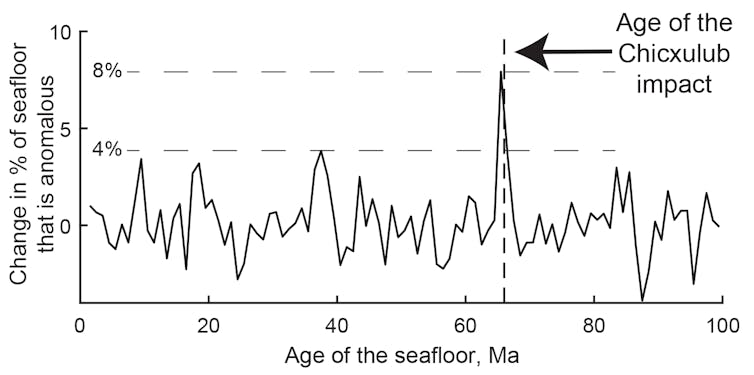
We then inspected the record of these “gravity anomalies” to look for any changes to the structure of the seafloor that happened quickly. We found an unusual abundance of these small structural anomalies on the seafloor happened within 1 million years of the Chicxulub impact. The gravity anomalies are consistent with roughly 650 foot high piles of excess material lying on 66-million-year-old seafloor in the Indian and Pacific Oceans.
The total volume of excess material is difficult to pin down, because a large amount of magma could have been injected into the lower crust where it would have a weaker gravitational signature. But we estimate that around the time of the Chicxulub impact, on the order of 23,000 to 230,000 cubic miles of magma erupted out of the mid-ocean ridges, all over the globe. This is on par with the largest eruptive events in Earth’s 4.5-billion-year history, including the Deccan Traps.
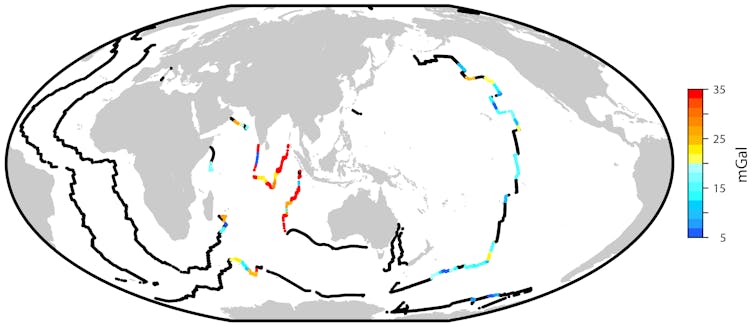
Refining the picture
Our observations suggest the following sequence of events at the end of the Cretaceous period. Just over 66 million years ago, the Deccan Traps start erupting – likely initiated by a plume of hot rock rising from the Earth’s core, similar in some ways to what’s happening beneath Hawaii or Yellowstone today, that impinged on the side of India’s tectonic plate. The mid-ocean ridges and dinosaurs continue their normal activity.
About 250,000 years later, Chicxulub hits off the coast of what will become Mexico. The impact causes a massive disruption to the Earth’s climate, injecting particles into the atmosphere that will eventually settle into a layer of clay found across the planet. In the aftermath of impact, volcanic activity accelerates for perhaps tens to hundreds of thousands of years. The mid-ocean ridges erupt large volumes of magma, while the Deccan Traps eruptions flood lava across much of the Indian subcontinent. In the end, three-quarters of the Earth’s plant and animal species have disappeared; the only remaining dinosaurs are the feathered, flying variety, normally referred to as birds.
Now, the goal is to further refine our understanding of each event and their interactions. Was there enough mid-ocean ridge activity to contribute to the mass extinction, or was the triggered submarine volcanism merely a symptom of some more significant planetary ailment? Were other volcanic systems triggered by the Chicxulub impact? Which played a larger role in driving the extinction: the volcanism or the meteor?
What is clear is that this new research points to global-scale connections between catastrophes, a good reminder that events happening on the other side of the planet can have effects felt everywhere.

